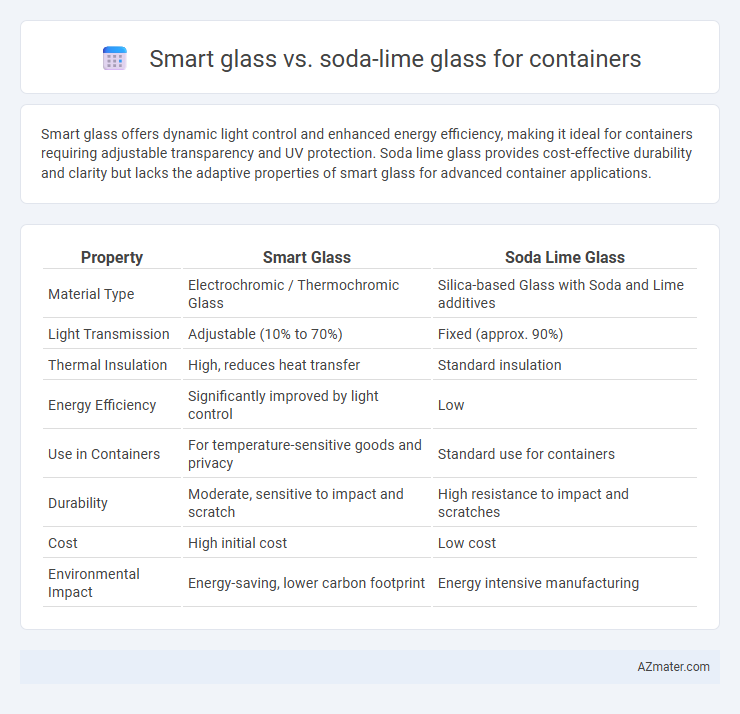Smart glass offers dynamic light control and enhanced energy efficiency, making it ideal for containers requiring adjustable transparency and UV protection. Soda lime glass provides cost-effective durability and clarity but lacks the adaptive properties of smart glass for advanced container applications.
Table of Comparison
| Property | Smart Glass | Soda Lime Glass |
|---|---|---|
| Material Type | Electrochromic / Thermochromic Glass | Silica-based Glass with Soda and Lime additives |
| Light Transmission | Adjustable (10% to 70%) | Fixed (approx. 90%) |
| Thermal Insulation | High, reduces heat transfer | Standard insulation |
| Energy Efficiency | Significantly improved by light control | Low |
| Use in Containers | For temperature-sensitive goods and privacy | Standard use for containers |
| Durability | Moderate, sensitive to impact and scratch | High resistance to impact and scratches |
| Cost | High initial cost | Low cost |
| Environmental Impact | Energy-saving, lower carbon footprint | Energy intensive manufacturing |
Overview of Container Glass Materials
Smart glass for containers offers dynamic light control and enhanced thermal insulation, making it ideal for products sensitive to UV and heat exposure. Soda lime glass, the most common container material, provides robust durability, chemical resistance, and cost-effective mass production capabilities. Both materials cater to specific packaging needs, with smart glass prioritizing advanced functional properties and soda lime glass focusing on traditional strength and economy.
What is Smart Glass?
Smart glass, also known as switchable glass, incorporates technologies such as electrochromic, photochromic, or thermochromic layers to control light transmission and opacity in real-time, enhancing energy efficiency and privacy in containers. Unlike traditional soda lime glass, which is a basic, transparent material made primarily from silica, soda ash, and lime, smart glass offers dynamic functionality by changing transparency on demand. This capability makes smart glass ideal for modern container applications requiring adaptable visibility and thermal control.
What is Soda Lime Glass?
Soda lime glass is the most common type of glass used in container manufacturing due to its affordability, durability, and ease of production. It primarily consists of silica (about 70-75%), soda (sodium oxide), and lime (calcium oxide), which together create a stable and versatile material suitable for bottles and jars. Unlike smart glass that offers dynamic light control and energy efficiency, soda lime glass provides a reliable, inert barrier, making it an ideal choice for food and beverage packaging.
Manufacturing Process Differences
Smart glass and soda lime glass differ significantly in their manufacturing processes, impacting performance and applications in containers. Soda lime glass is produced through a basic batch melting process involving silica, soda ash, and lime, followed by forming and annealing, which makes it cost-effective for mass container production. In contrast, smart glass incorporates additional thin-film coatings or electrochromic layers applied post-formation, requiring advanced deposition techniques and precise control to enable dynamic light modulation features.
Physical and Chemical Properties Comparison
Smart glass exhibits dynamic optical properties with variable light transmission enabled by electrochromic or thermochromic technology, while soda lime glass has stable, fixed transparency. Chemically, soda lime glass is composed primarily of silica, sodium oxide, and calcium oxide, offering excellent chemical durability suitable for container applications; smart glass contains additional functional layers and coatings that may affect its chemical resistance. Physically, soda lime glass provides high mechanical strength and thermal stability, whereas smart glass may have reduced mechanical robustness due to embedded electronic elements and multilayer structures.
Strength and Durability: Smart Glass vs Soda Lime Glass
Smart glass offers enhanced strength and durability compared to traditional soda lime glass, making it more resistant to impacts and temperature variations. Soda lime glass, commonly used in containers, is prone to chipping and cracking under stress, while smart glass incorporates advanced coatings or laminations that improve its structural integrity. These improvements in smart glass result in longer-lasting containers suitable for various demanding applications.
Energy Efficiency and Sustainability
Smart glass for containers significantly enhances energy efficiency by reducing heat transfer and limiting ultraviolet light exposure, which helps maintain product temperature and extends shelf life. Soda lime glass, while widely used due to low cost and chemical durability, lacks the energy-saving properties found in smart glass, leading to higher energy consumption during storage and transportation. The sustainability advantage of smart glass stems from its ability to lower carbon footprints through reduced cooling needs and improved resource longevity, positioning it as a greener alternative to traditional soda lime glass.
Cost and Availability for Containers
Smart glass containers typically incur higher costs due to advanced manufacturing processes and embedded technologies like electrochromic or thermochromic coatings. Soda lime glass, as the most common and widely produced glass type, offers significantly lower prices and higher availability, making it the preferred choice for large-scale container production. The cost-effectiveness and widespread supply chain infrastructure of soda lime glass ensure its dominance in packaging industries compared to the niche, premium market of smart glass containers.
Common Applications in Packaging
Smart glass, also known as switchable glass, finds limited use in packaging primarily for premium or specialty containers where light control and privacy are essential, such as in certain cosmetic or pharmaceutical applications. Soda lime glass dominates the packaging industry due to its cost-effectiveness, durability, and excellent barrier properties, making it ideal for beverage bottles, food jars, and other mass-market containers. The widespread adoption of soda lime glass is driven by its recyclability and compatibility with various filling processes.
Choosing the Right Glass for Containers
Smart glass offers advanced light control and energy efficiency, making it ideal for containers requiring temperature regulation and UV protection. Soda lime glass is cost-effective and widely used for standard container production, offering good durability but limited protective features. Choosing the right glass depends on specific storage needs, with smart glass suited for sensitive contents and soda lime glass preferred for everyday packaging.

Infographic: Smart glass vs Soda lime glass for Container
 azmater.com
azmater.com